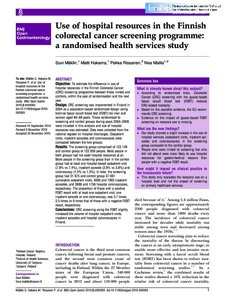Use of hospital resources in the Finnish colorectal cancer screening programme: a randomised health services study
Mäklin, Suvi; Hakama, Matti; Rissanen, Pekka; Malila, Nea (2015)
Mäklin, Suvi
Hakama, Matti
Rissanen, Pekka
Malila, Nea
2015
BMJ Open Gastroenterology 2 1
e000063
Terveystieteiden yksikkö - School of Health Sciences
Julkaisun pysyvä osoite on
https://urn.fi/URN:NBN:fi:uta-201605181612
https://urn.fi/URN:NBN:fi:uta-201605181612
Tiivistelmä
Objective
To estimate the difference in use of hospital resources in the Finnish Colorectal Cancer (CRC) screening programme between those invited and controls, within the year of randomisation and the next year.
Design
CRC screening was implemented in Finland in 2004 as a population-based randomised design using biennial faecal occult blood test (FOBT) for men and women aged 60–69 years. Those randomised to screening and control groups during years 2004–2009 were included in this analysis and use of hospital resources was estimated. Data were collected from the national register on hospital discharges. Outpatient visits, inpatient episodes and colonoscopies were compared between the two groups.
Results
The screening group comprised of 123 149 and control group of 122 930 people. Most people in both groups had not used hospital resources at all. More people in the screening group than in the control group had at least one hospital-based outpatient visit (7.8% vs 7.4%), inpatient episode (3.9% vs 3.8%) and colonoscopy (1.5% vs 1.3%). In total, the screening group had 31 975 and control group 27 061 cumulative outpatient visits, 9260 and 7903 inpatient episodes, and 2686 and 1756 hospital colonoscopies, respectively. The proportion of those with a positive FOBT result with at least one outpatient visit, one inpatient episode or one colonoscopy, was 3.7 times, 2.5 times or 9 times that of those with a negative FOBT result, respectively.
Conclusions
CRC screening using the FOBT slightly increased the volume of hospital outpatient visits, inpatient episodes and hospital colonoscopies in Finland.
To estimate the difference in use of hospital resources in the Finnish Colorectal Cancer (CRC) screening programme between those invited and controls, within the year of randomisation and the next year.
Design
CRC screening was implemented in Finland in 2004 as a population-based randomised design using biennial faecal occult blood test (FOBT) for men and women aged 60–69 years. Those randomised to screening and control groups during years 2004–2009 were included in this analysis and use of hospital resources was estimated. Data were collected from the national register on hospital discharges. Outpatient visits, inpatient episodes and colonoscopies were compared between the two groups.
Results
The screening group comprised of 123 149 and control group of 122 930 people. Most people in both groups had not used hospital resources at all. More people in the screening group than in the control group had at least one hospital-based outpatient visit (7.8% vs 7.4%), inpatient episode (3.9% vs 3.8%) and colonoscopy (1.5% vs 1.3%). In total, the screening group had 31 975 and control group 27 061 cumulative outpatient visits, 9260 and 7903 inpatient episodes, and 2686 and 1756 hospital colonoscopies, respectively. The proportion of those with a positive FOBT result with at least one outpatient visit, one inpatient episode or one colonoscopy, was 3.7 times, 2.5 times or 9 times that of those with a negative FOBT result, respectively.
Conclusions
CRC screening using the FOBT slightly increased the volume of hospital outpatient visits, inpatient episodes and hospital colonoscopies in Finland.
Kokoelmat
- Artikkelit [6140]
